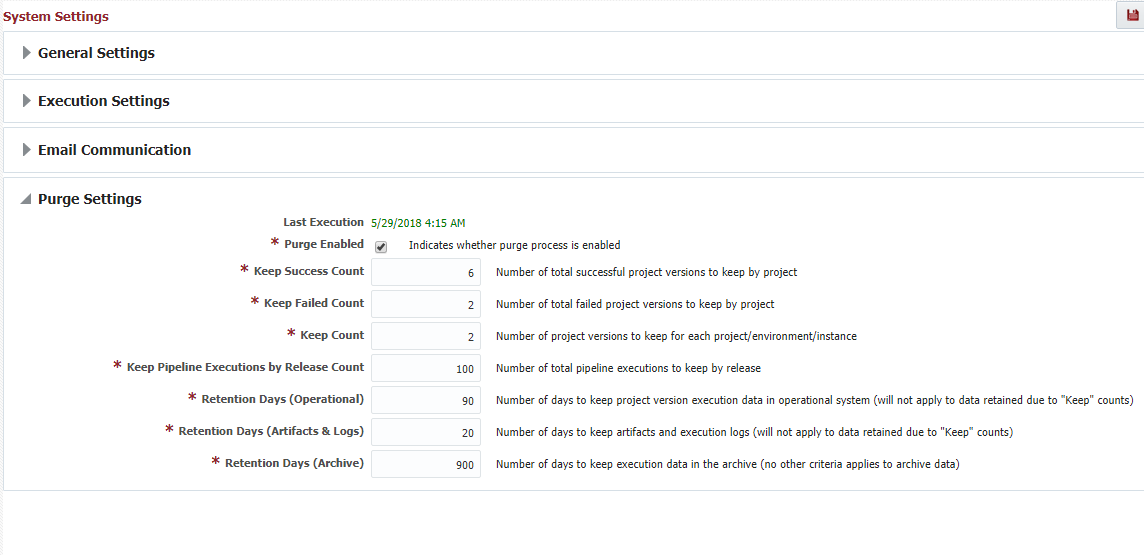The Purge Settings define the configuration parameters to manage the archiving and purging of FlexDeploy execution data from the database repository, and purging of the artifacts stored in the artifacts repository.
| Property | Description | |||
|---|---|---|---|---|
Purge Enabled | Indicates whether the purge process is enabled. Purge runs every day if enabled. Run time is dependent on when FlexDeploy was started. If you have concerns with running purge at some specific milestone deployment event, you can disable Purge temporarily. | |||
| Keep Success Count | How many successful project version builds to keep regardless of Retention Days (Operational) (Note: this is a global setting and not specific to an environment/instance) | |||
| Keep Failed Count | How many | days of execution data to keep in the operational tables. After this data will be moved to Archive tables. Age of data is determined based on original created time.failed project version builds to keep regardless of Retention Days ( | Artifacts)How many days of artifacts to keep in the file system. If Keep Counts discussed below cause the version to be active, Artifacts for those will be kept as well.Operational) (Note: this is a global setting and not specific to an environment/instance) | |
| Keep Count | How many project versions to keep for each environment/instance regardless of Retention Days (Operational). This helps you keep specific number of latest deployments so that you can back out to previous versions if desired. | |||
| Keep | SuccessPipeline Executions by Release Count | How many | successful project version buildspipeline executions to keep | regardless ofper release. |
Retention Days (Operational) (Note: this is a global setting and not specific to an environment/instance) | Keep Failed Count | How many failed project version builds to keep regardless of Retention Days (Operational) (Note: this is a global setting and not specific to an environment/instance)days of execution data to keep in the operational tables. After this data will be moved to Archive tables. Age of data is determined based on original created time. | ||
Retention Days (Artifacts and Logs) | How many days to keep artifacts and execution logs for data that doesn't fall into the "Keep" settings above before deleting them. | |||
Retention Days (Archive) | How many days of execution data to keep in the archive tables. Age of data is determined based on original created time. This means that you should keep this value higher than Retention Days (Operational). | |||
| Retention Days for Logs | How many days of execution data to keep in the log tables. This means workflow execution steps detail and plugin logs. These tables take most of amount of space in database, so it is advisable to control this value to reduce space usage. Logs data is now not archived. You can delete all data from ARC_PLUGIN_EXECUTION_LOG and ARC_WORKFLOW_EXECUTION_DATA tables if you want to free up space in your database. | |||
| Number of successful pipeline executions to keep | Number of successful of running pipeline executions to keep in operational tables. | |||
| Number of unsuccessful pipeline executions to keep | Number of aborted, failed , skipped, or out-of-date pipeline executions to keep in operational tablesNo criteria are performed on the data which is already in the archive tables other than time. |
Purge Rules
- Any workflow execution that is the last successful deployment to an environment is automatically excluded from the purge.
- The three four KEEP related parameters override the
DAYSparameter parameters (i.e. ifRetention Days (Operational)is 1 day, anything that was deployed more than 1 day ago AND is one that needs to be kept to satisfy theKEEPparameters will be excluded from the archive/purge). - The
Retention Days (Artifacts)only affects the removal of the artifacts from the file system. There is no archive of artifacts . TheKEEPparameters will again override the artifact retention days. When the or plugin logs. - When artifacts have been purged, a red circle will appear on the project version (as shown in figure 17.28) indicating that the artifacts have been purged. This project version will also no longer be available to deploy to any environment. To redeploy this version, the version of the source would need to be retrieved from source code repository (like SVN) in use and taken through the build/deploy cycle again.
- The
Retention Daysare based on the first date it finds in this sequence: End time of the workflow execution, start time of the workflow execution, created time of the workflow execution, requested start time of the workflow request, or the created time of the workflow request.
...

